Full text
PDF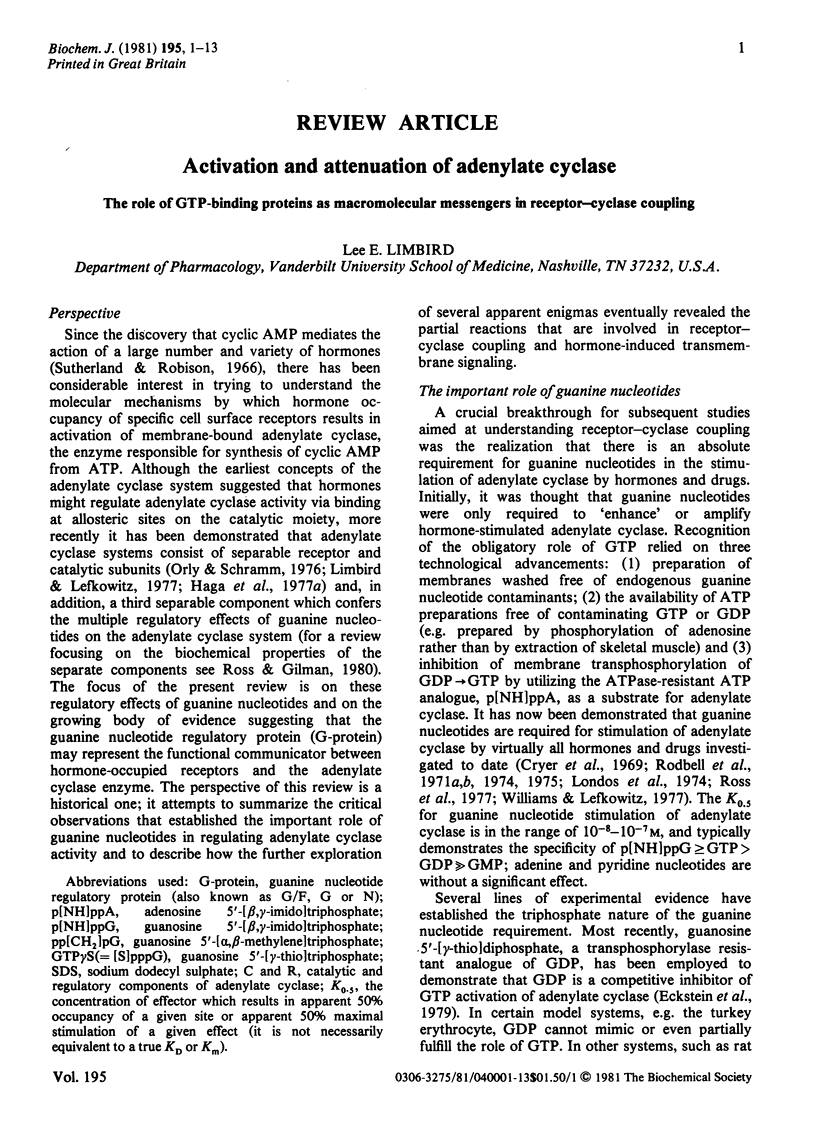
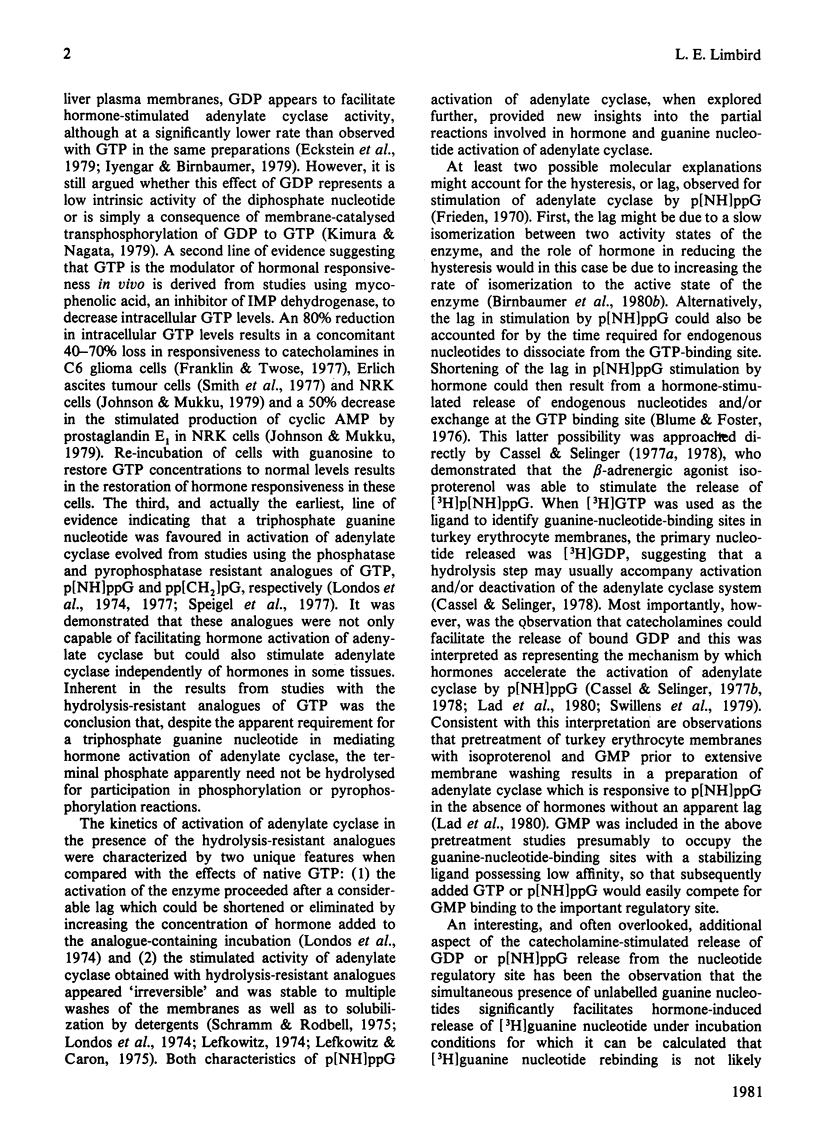
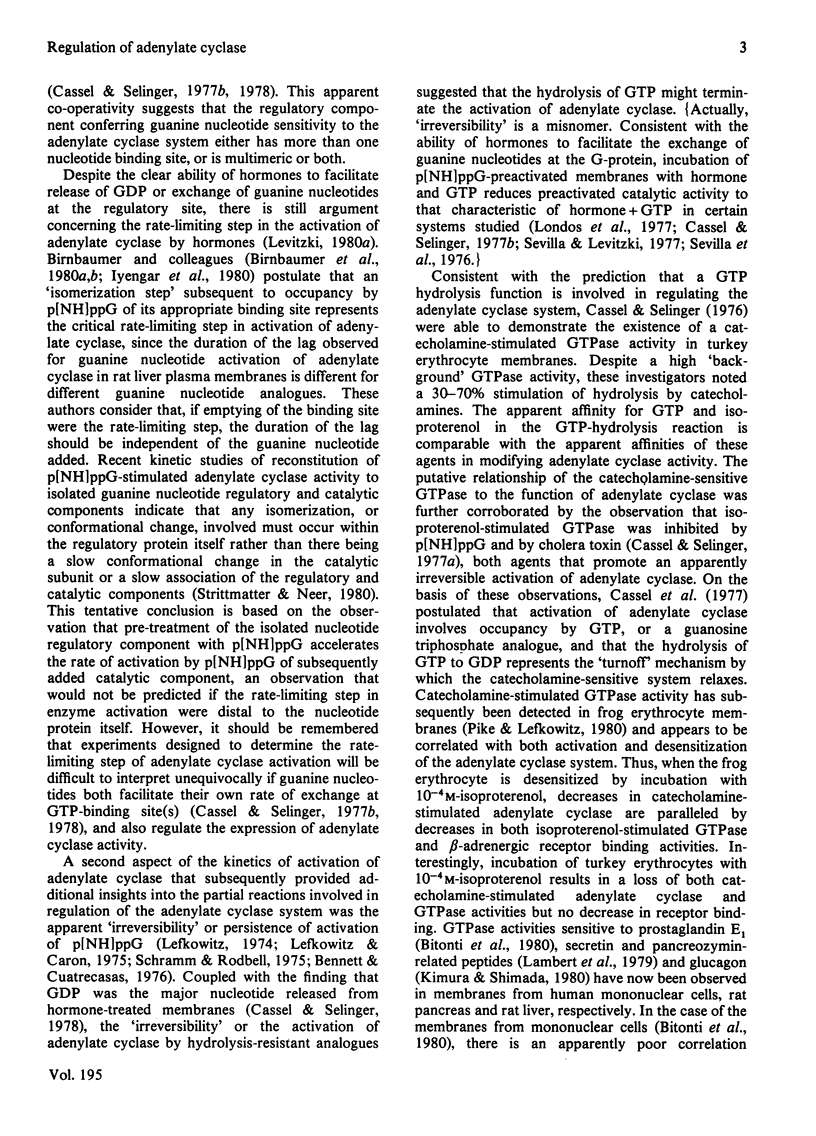
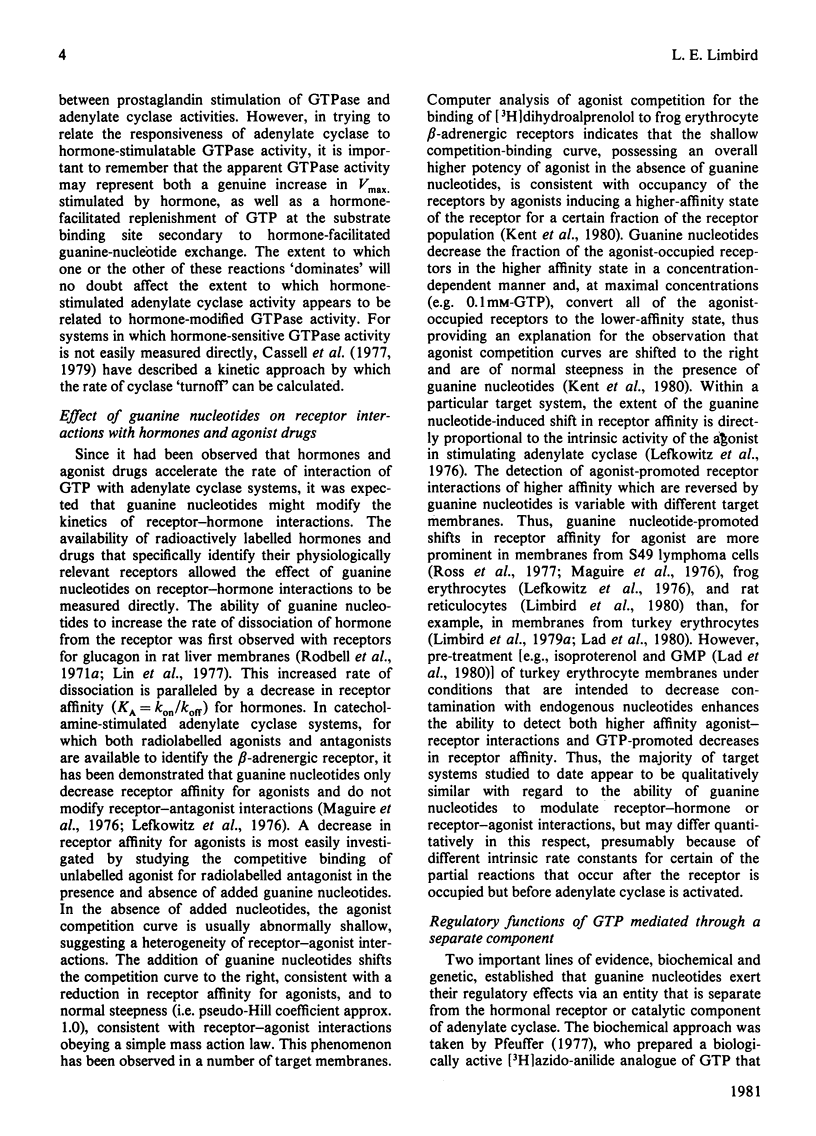
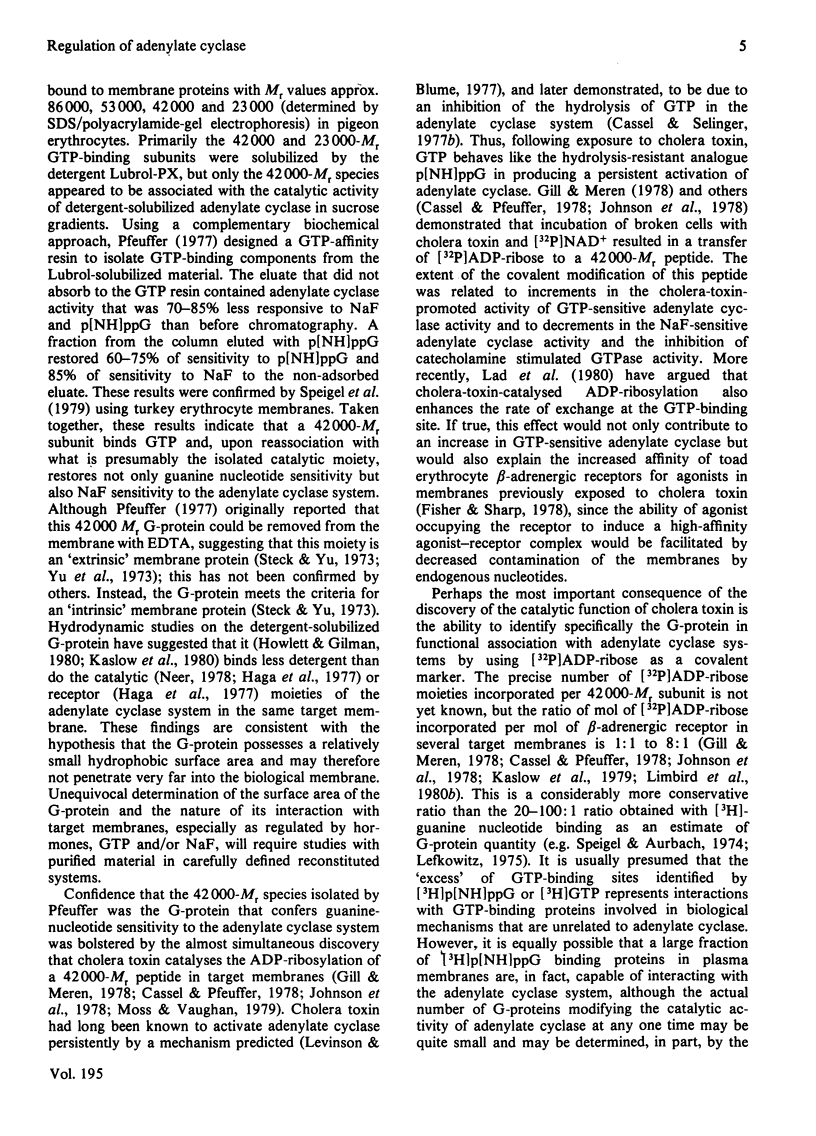
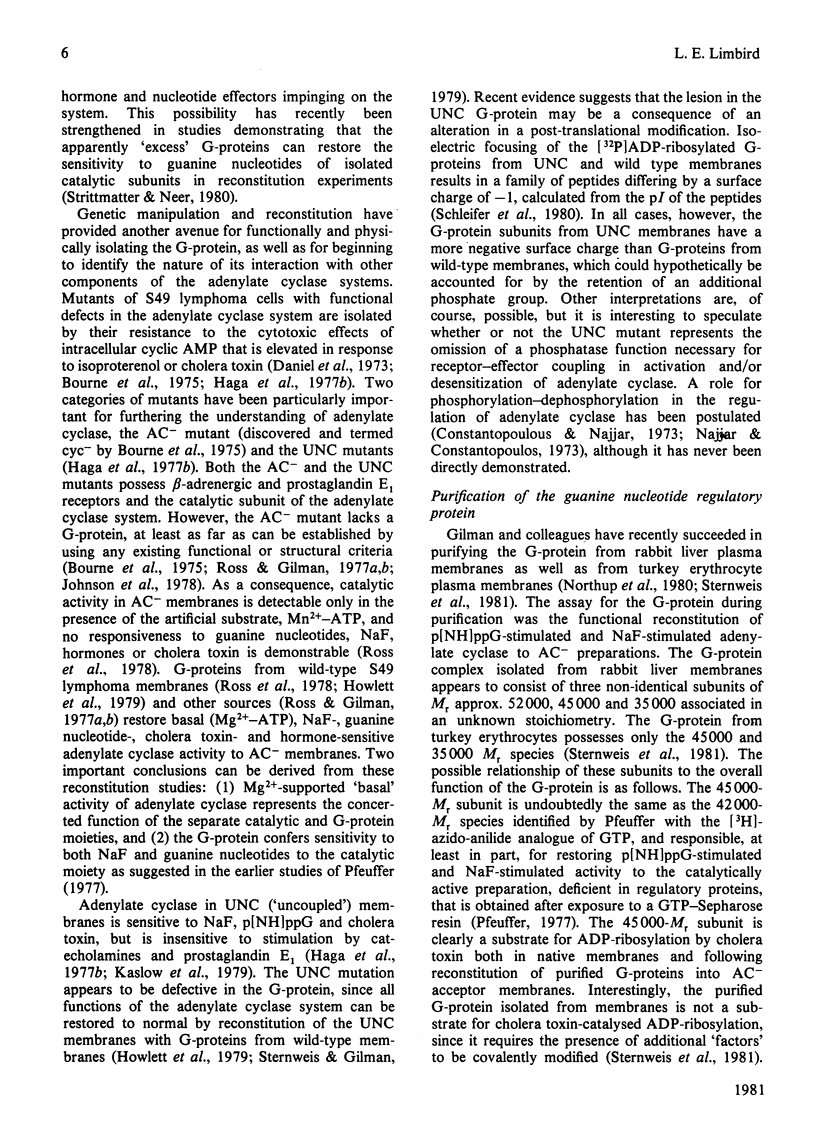
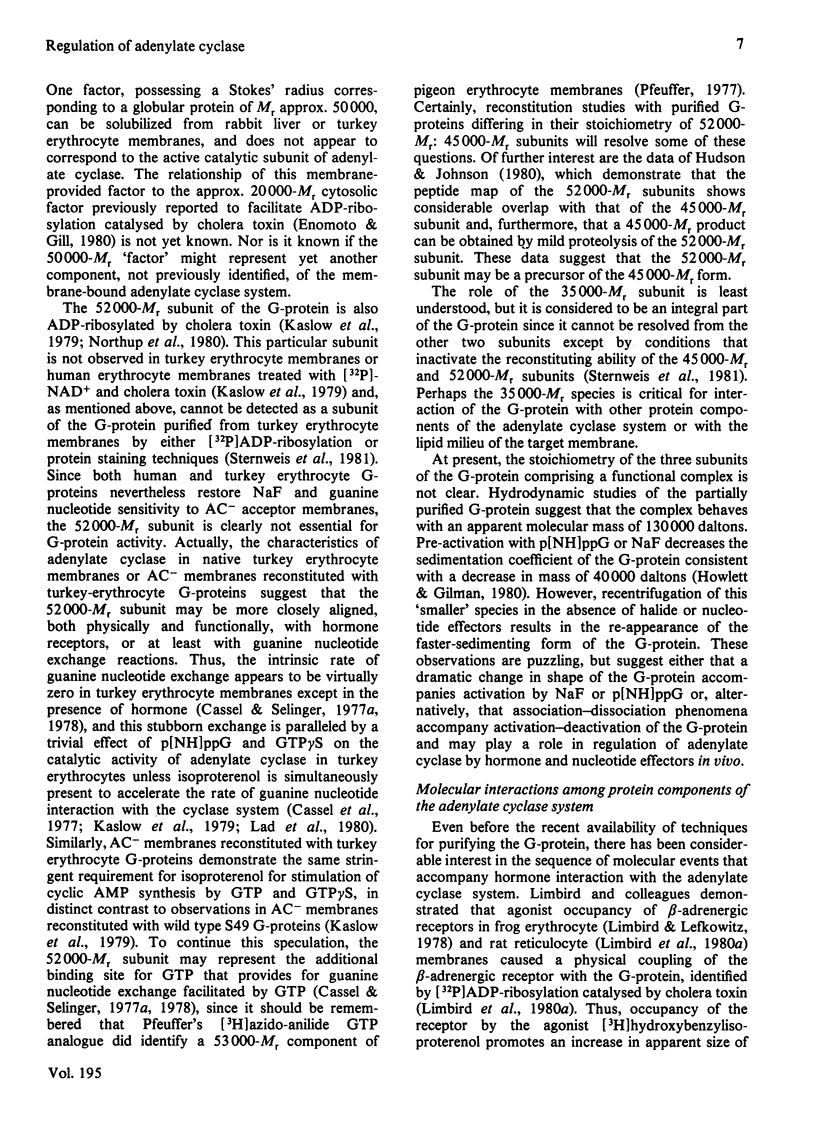
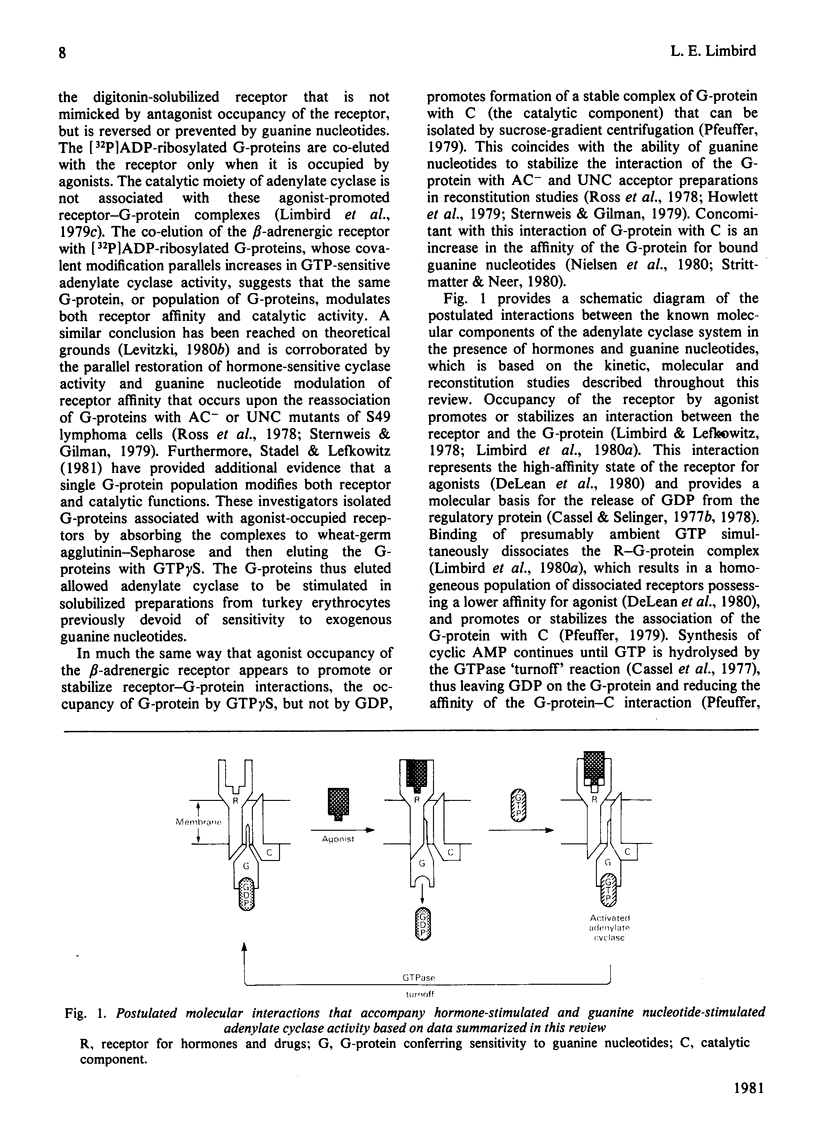
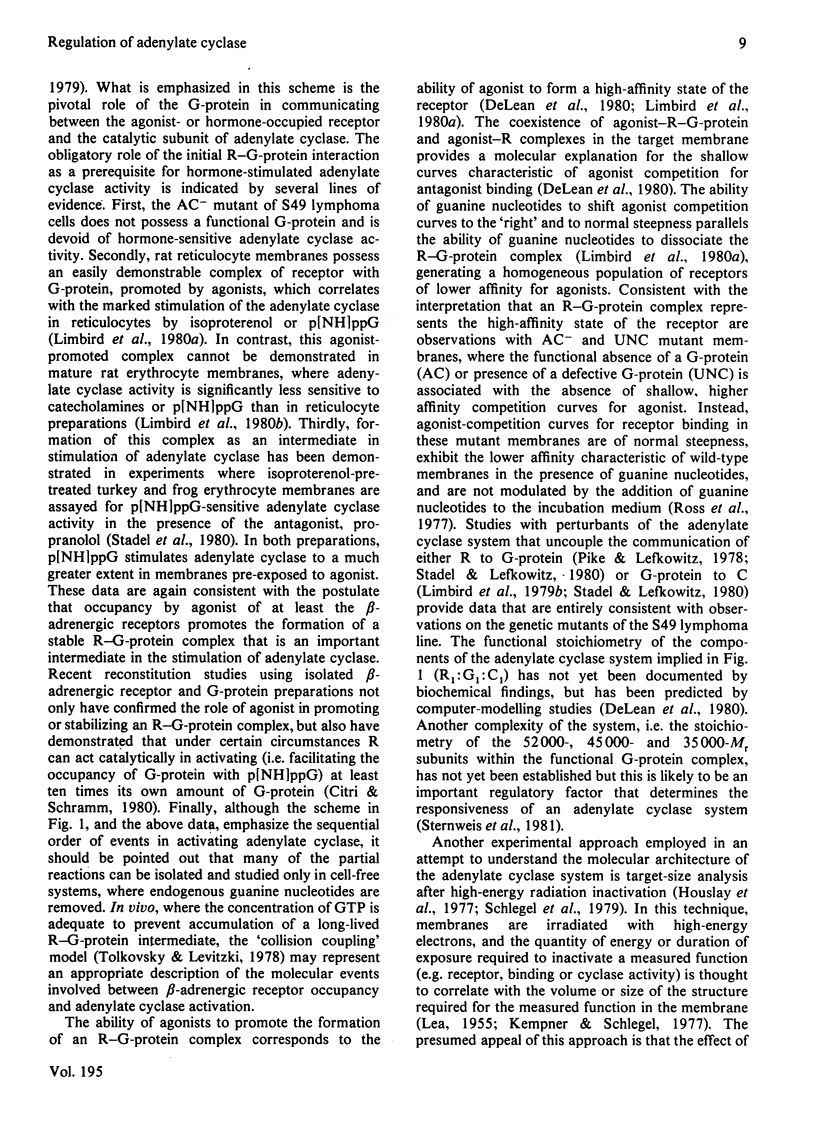
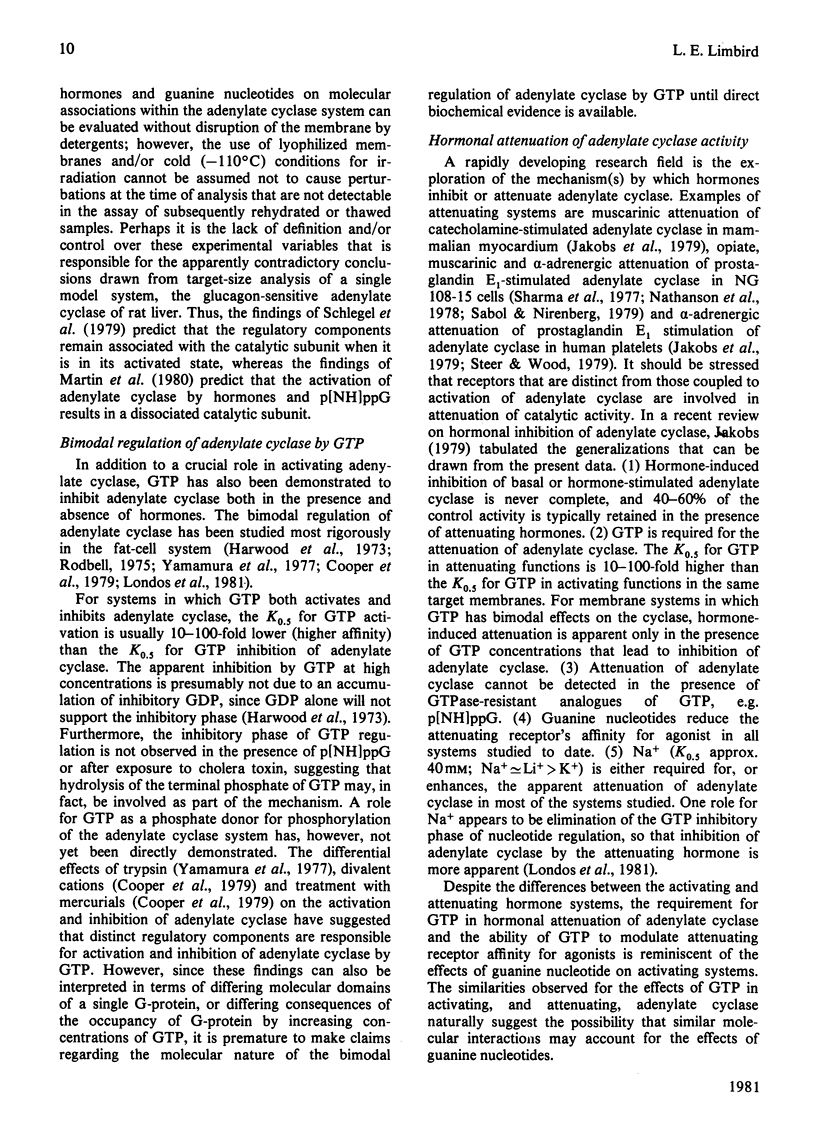
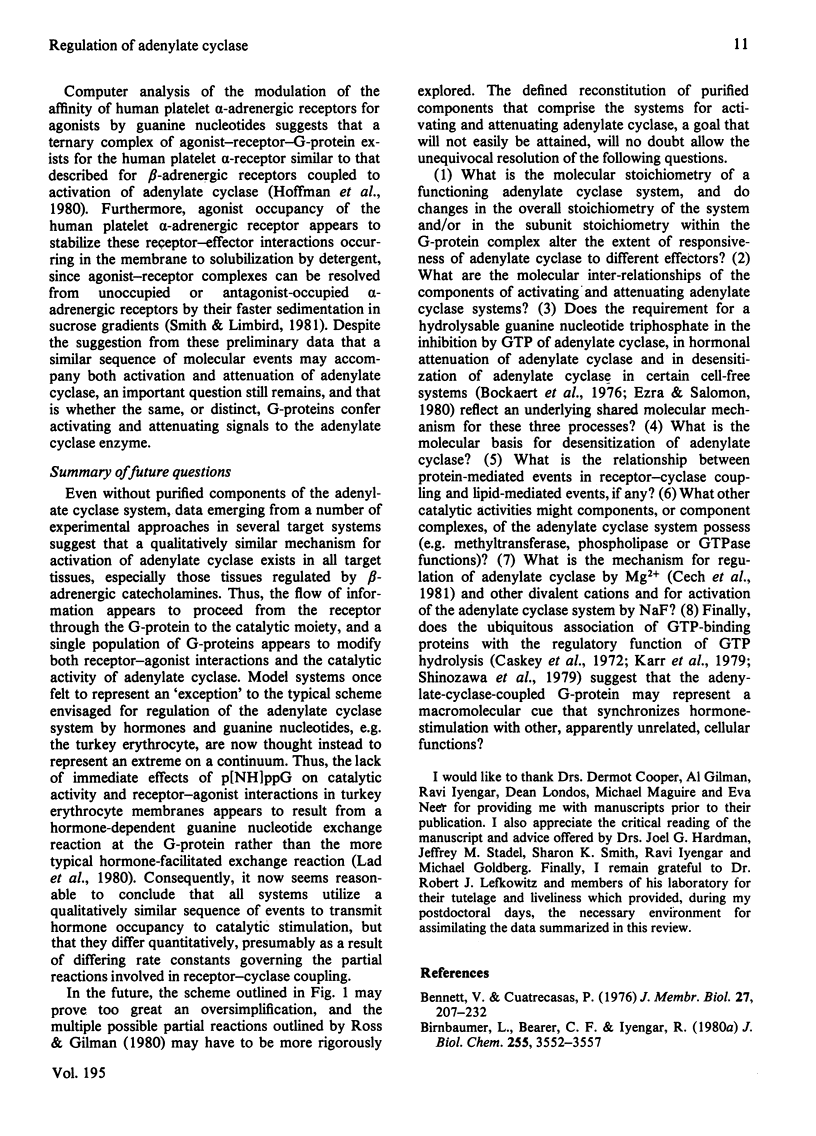
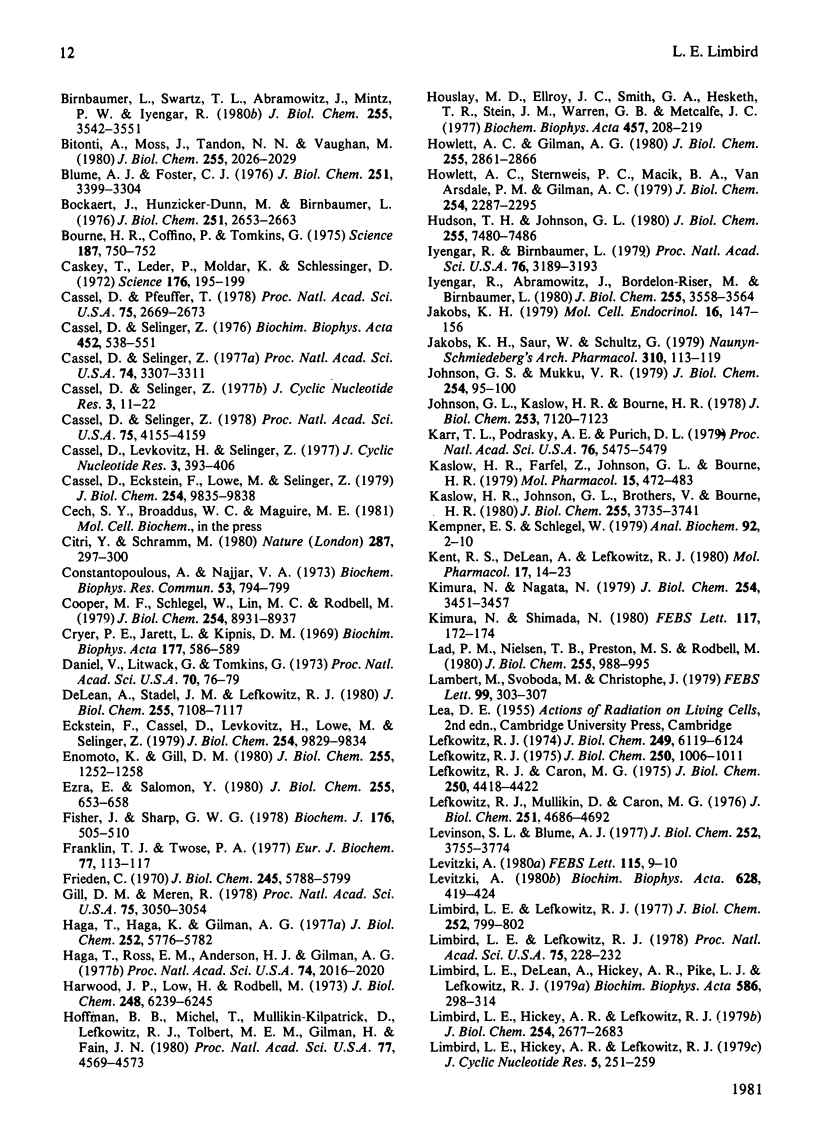
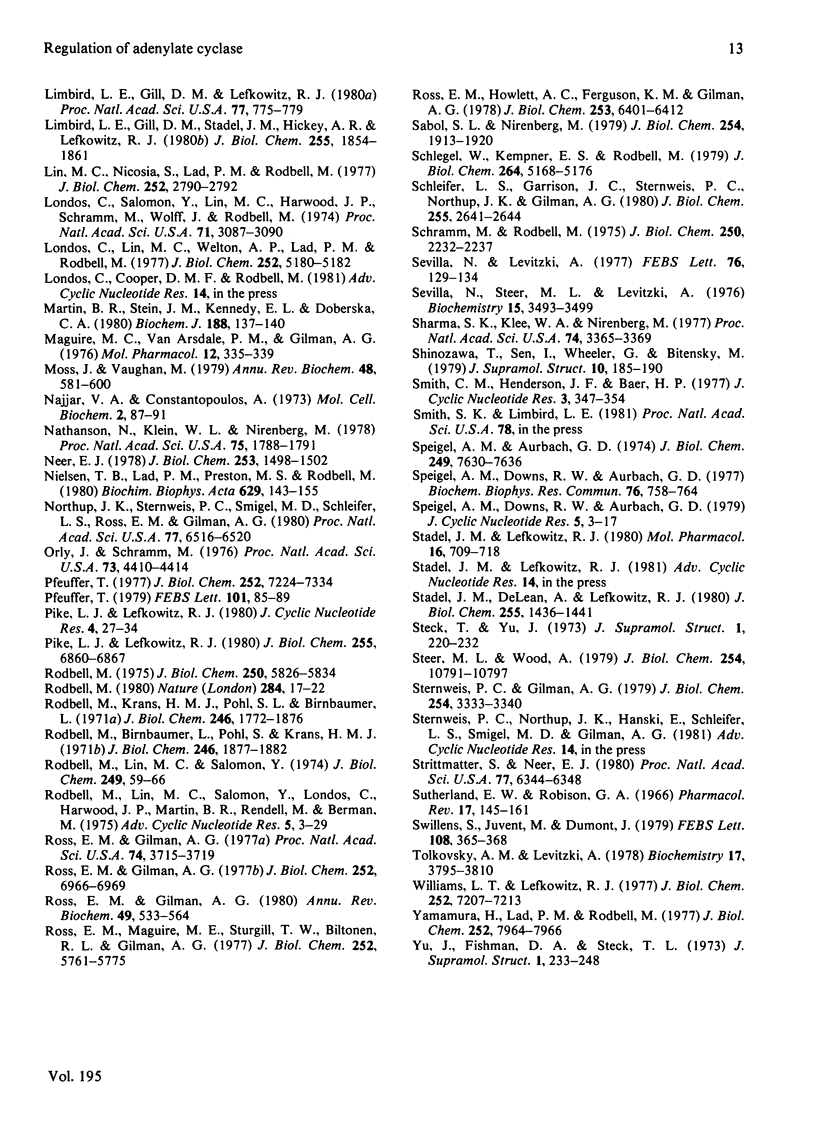
Selected References
These references are in PubMed. This may not be the complete list of references from this article.
- Bennett V., Cuatrecasas P. Irreversible activation of adenylate cyclase of toad erythrocyte plasma membrane by 5'-guanylylimidodiphosphate. J Membr Biol. 1976;27(3):207–232. doi: 10.1007/BF01869137. [DOI] [PubMed] [Google Scholar]
- Birnbaumer L., Bearer C. F., Iyengar R. A two-state model of an enzyme with an allosteric regulatory site capable of metabolizing the regulatory ligand. Simplified mathematical treatments of transient and steady state kinetics of an activator and its competitive inhibition as applied to adenylyl cyclases. J Biol Chem. 1980 Apr 25;255(8):3552–3557. [PubMed] [Google Scholar]
- Birnbaumer L., Swartz T. L., Abramowitz J., Mintz P. W., Iyengar R. Transient and steady state kinetics of the interaction of guanyl nucleotides with the adenylyl cyclase system from rat liver plasma membranes. Interpretation in terms of a simple two-state model. J Biol Chem. 1980 Apr 25;255(8):3542–3551. [PubMed] [Google Scholar]
- Bitonti A. J., Moss J., Tandon N. N., Vaughan M. Prostaglandins increase GTP hydrolysis by membranes from human mononuclear cells. J Biol Chem. 1980 Mar 10;255(5):2026–2029. [PubMed] [Google Scholar]
- Blume A. J., Foster C. J. Neuroblastoma adenylate cyclase. Role of 2-chloroadenosine, prostaglandin E1, and guanine nucleotides in regulation of activity. J Biol Chem. 1976 Jun 10;251(11):3399–3404. [PubMed] [Google Scholar]
- Bockaert J., Hunzicker-Dunn M., Birnbaumer L. Hormone-stimulated desensitization of hormone-dependent adenylyl cyclase. Dual action of luteninizing hormone on pig graafian follicle membranes. J Biol Chem. 1976 May 10;251(9):2653–2663. [PubMed] [Google Scholar]
- Bourne H. R., Coffino P., Tomkins G. M. Selection of a variant lymphoma cell deficient in adenylate cyclase. Science. 1975 Feb 28;187(4178):750–752. doi: 10.1126/science.163487. [DOI] [PubMed] [Google Scholar]
- Caskey T., Leder P., Moldave K., Schlessinger D. Translation: its mechanism and control. Science. 1972 Apr 14;176(4031):195–197. doi: 10.1126/science.176.4031.195. [DOI] [PubMed] [Google Scholar]
- Cassel D., Eckstein F., Lowe M., Selinger Z. Determination of the turn-off reaction for the hormone-activated adenylate cyclase. J Biol Chem. 1979 Oct 10;254(19):9835–9838. [PubMed] [Google Scholar]
- Cassel D., Levkovitz H., Selinger Z. The regulatory GTPase cycle of turkey erythrocyte adenylate cyclase. J Cyclic Nucleotide Res. 1977 Dec;3(6):393–406. [PubMed] [Google Scholar]
- Cassel D., Pfeuffer T. Mechanism of cholera toxin action: covalent modification of the guanyl nucleotide-binding protein of the adenylate cyclase system. Proc Natl Acad Sci U S A. 1978 Jun;75(6):2669–2673. doi: 10.1073/pnas.75.6.2669. [DOI] [PMC free article] [PubMed] [Google Scholar]
- Cassel D., Selinger Z. Catecholamine-induced release of [3H]-Gpp(NH)p from turkey erythrocyte adenylate cyclase. J Cyclic Nucleotide Res. 1977 Feb;3(1):11–22. [PubMed] [Google Scholar]
- Cassel D., Selinger Z. Catecholamine-stimulated GTPase activity in turkey erythrocyte membranes. Biochim Biophys Acta. 1976 Dec 8;452(2):538–551. doi: 10.1016/0005-2744(76)90206-0. [DOI] [PubMed] [Google Scholar]
- Cassel D., Selinger Z. Mechanism of adenylate cyclase activation by cholera toxin: inhibition of GTP hydrolysis at the regulatory site. Proc Natl Acad Sci U S A. 1977 Aug;74(8):3307–3311. doi: 10.1073/pnas.74.8.3307. [DOI] [PMC free article] [PubMed] [Google Scholar]
- Cassel D., Selinger Z. Mechanism of adenylate cyclase activation through the beta-adrenergic receptor: catecholamine-induced displacement of bound GDP by GTP. Proc Natl Acad Sci U S A. 1978 Sep;75(9):4155–4159. doi: 10.1073/pnas.75.9.4155. [DOI] [PMC free article] [PubMed] [Google Scholar]
- Citri Y., Schramm M. Resolution, reconstitution and kinetics of the primary action of a hormone receptor. Nature. 1980 Sep 25;287(5780):297–300. doi: 10.1038/287297a0. [DOI] [PubMed] [Google Scholar]
- Constantopoulos A., Najjar V. A. The activation of adenylate cyclase. II. The postulated presence of (A) adenylate cyclase in a phospho (inhibited) form (B) a dephospho (activated) form with a cyclic adenylate stimulated membrane protein kinase. Biochem Biophys Res Commun. 1973 Aug 6;53(3):794–799. doi: 10.1016/0006-291x(73)90162-9. [DOI] [PubMed] [Google Scholar]
- Cooper D. M., Schlegel W., Lin M. C., Rodbell M. The fat cell adenylate cyclase system. Characterization and manipulation of its bimodal regulation by GTP. J Biol Chem. 1979 Sep 25;254(18):8927–8931. [PubMed] [Google Scholar]
- Cryer P. E., Jarett L., Kipnis D. M. Nucleotide inhibition of adenyl cyclase activity in fat cell membranes. Biochim Biophys Acta. 1969 May 6;177(3):586–590. doi: 10.1016/0304-4165(69)90323-7. [DOI] [PubMed] [Google Scholar]
- Daniel V., Litwack G., Tomkins G. M. Induction of cytolysis of cultured lymphoma cells by adenosine 3':5'-cyclic monophosphate and the isolation of resistant variants. Proc Natl Acad Sci U S A. 1973 Jan;70(1):76–79. doi: 10.1073/pnas.70.1.76. [DOI] [PMC free article] [PubMed] [Google Scholar]
- De Lean A., Stadel J. M., Lefkowitz R. J. A ternary complex model explains the agonist-specific binding properties of the adenylate cyclase-coupled beta-adrenergic receptor. J Biol Chem. 1980 Aug 10;255(15):7108–7117. [PubMed] [Google Scholar]
- Eckstein F., Cassel D., Levkovitz H., Lowe M., Selinger Z. Guanosine 5'-O-(2-thiodiphosphate). An inhibitor of adenylate cyclase stimulation by guanine nucleotides and fluoride ions. J Biol Chem. 1979 Oct 10;254(19):9829–9834. [PubMed] [Google Scholar]
- Enomoto K., Gill D. M. Cholera toxin activation of adenylate cyclase. Roles of nucleoside triphosphates and a macromolecular factor in the ADP ribosylation of the GTP-dependent regulatory component. J Biol Chem. 1980 Feb 25;255(4):1252–1258. [PubMed] [Google Scholar]
- Ezra E., Salomon Y. Mechanism of desensitization of adenylate cyclase in lutropin. GTP-dependent uncoupling of the receptor. J Biol Chem. 1980 Jan 25;255(2):653–658. [PubMed] [Google Scholar]
- Fischer J., Sharp G. W. Effects of cholera toxin and guanosine 5'-[betagamma-imido]triphosphate on beta-adrenergic-receptor affinity. Biochem J. 1978 Nov 15;176(2):505–510. doi: 10.1042/bj1760505. [DOI] [PMC free article] [PubMed] [Google Scholar]
- Franklin T. J., Twose P. A. Reduction in beta-adrenergic response of cultured glioma cells following depletion of intracellular GTP. Eur J Biochem. 1977 Jul 1;77(1):113–117. doi: 10.1111/j.1432-1033.1977.tb11648.x. [DOI] [PubMed] [Google Scholar]
- Frieden C. Kinetic aspects of regulation of metabolic processes. The hysteretic enzyme concept. J Biol Chem. 1970 Nov 10;245(21):5788–5799. [PubMed] [Google Scholar]
- Gill D. M., Meren R. ADP-ribosylation of membrane proteins catalyzed by cholera toxin: basis of the activation of adenylate cyclase. Proc Natl Acad Sci U S A. 1978 Jul;75(7):3050–3054. doi: 10.1073/pnas.75.7.3050. [DOI] [PMC free article] [PubMed] [Google Scholar]
- Haga T., Haga K., Gilman A. G. Hydrodynamic properties of the beta-adrenergic receptor and adenylate cyclase from wild type and varient S49 lymphoma cells. J Biol Chem. 1977 Aug 25;252(16):5776–5782. [PubMed] [Google Scholar]
- Haga T., Ross E. M., Anderson H. J., Gilman A. G. Adenylate cyclase permanently uncoupled from hormone receptors in a novel variant of S49 mouse lymphoma cells. Proc Natl Acad Sci U S A. 1977 May;74(5):2016–2020. doi: 10.1073/pnas.74.5.2016. [DOI] [PMC free article] [PubMed] [Google Scholar]
- Harwood J. P., Löw H., Rodbell M. Stimulatory and inhibitory effects of guanyl nucleotides on fat cell adenylate cyclase. J Biol Chem. 1973 Sep 10;248(17):6239–6245. [PubMed] [Google Scholar]
- Hoffman B. B., Michel T., Kilpatrick D. M., Lefkowitz R. J., Tolbert M. E., Gilman H., Fain J. N. Agonist versus antagonist binding to alpha-adrenergic receptors. Proc Natl Acad Sci U S A. 1980 Aug;77(8):4569–4573. doi: 10.1073/pnas.77.8.4569. [DOI] [PMC free article] [PubMed] [Google Scholar]
- Houslay M. D., Ellory J. C., Smith G. A., Hesketh T. R., Stein J. M., Warren G. B., Metcalfe J. C. Exchange of partners in glucagon receptor-adenylate cyclase complexes. Physical evidence for the independent, mobile receptor model. Biochim Biophys Acta. 1977 Jun 2;467(2):208–219. doi: 10.1016/0005-2736(77)90197-3. [DOI] [PubMed] [Google Scholar]
- Howlett A. C., Gilman A. G. Hydrodynamic properties of the regulatory component of adenylate cyclase. J Biol Chem. 1980 Apr 10;255(7):2861–2866. [PubMed] [Google Scholar]
- Howlett A. C., Sternweis P. C., Macik B. A., Van Arsdale P. M., Gilman A. G. Reconstitution of catecholamine-sensitive adenylate cyclase. Association of a regulatory component of the enzyme with membranes containing the catalytic protein and beta-adrenergic receptors. J Biol Chem. 1979 Apr 10;254(7):2287–2295. [PubMed] [Google Scholar]
- Hudson T. H., Johnson G. L. Peptide mapping of adenylate cyclase regulatory proteins that are cholera toxin substrates. J Biol Chem. 1980 Aug 10;255(15):7480–7486. [PubMed] [Google Scholar]
- Iyengar R., Abramowitz J., Bordelon-Riser M., Birnbaumer L. Hormone receptor-mediated stimulation of adenylyl cyclase systems. Nucleotide effects and analysis in terms of a simple two-state model for the basic receptor-affected enzyme. J Biol Chem. 1980 Apr 25;255(8):3558–3564. [PubMed] [Google Scholar]
- Iyengar R., Birnbaumer L. Coupling of the glucagon receptor to adenylyl cyclase by GDP: evidence for two levels of regulation of adenylyl cyclase. Proc Natl Acad Sci U S A. 1979 Jul;76(7):3189–3193. doi: 10.1073/pnas.76.7.3189. [DOI] [PMC free article] [PubMed] [Google Scholar]
- Jakobs K. H., Aktories K., Schultz G. GTP-dependent inhibition of cardiac adenylate cyclase by muscarinic cholinergic agonists. Naunyn Schmiedebergs Arch Pharmacol. 1979 Dec;310(2):113–119. doi: 10.1007/BF00500275. [DOI] [PubMed] [Google Scholar]
- Jakobs K. H. Inhibition of adenylate cyclase by hormones and neurotransmitters. Mol Cell Endocrinol. 1979 Dec;16(3):147–156. doi: 10.1016/0303-7207(79)90023-6. [DOI] [PubMed] [Google Scholar]
- Johnson G. L., Kaslow H. R., Bourne H. R. Genetic evidence that cholera toxin substrates are regulatory components of adenylate cyclase. J Biol Chem. 1978 Oct 25;253(20):7120–7123. [PubMed] [Google Scholar]
- Johnson G. S., Mukku V. R. Evidence in intact cells for an involvement of GTP in the activation of adenylate cyclase. J Biol Chem. 1979 Jan 10;254(1):95–100. [PubMed] [Google Scholar]
- Karr T. L., Podrasky A. E., Purich D. L. Participation of guanine nucleotides in nucleation and elongation steps of microtubule assembly. Proc Natl Acad Sci U S A. 1979 Nov;76(11):5475–5479. doi: 10.1073/pnas.76.11.5475. [DOI] [PMC free article] [PubMed] [Google Scholar]
- Kaslow H. R., Farfel Z., Johnson G. L., Bourne H. R. Adenylate cyclase assembled in vitro: cholera toxin substrates determine different patterns of regulation by isoproterenol and guanosine 5'-triphosphate. Mol Pharmacol. 1979 May;15(3):472–483. [PubMed] [Google Scholar]
- Kaslow H. R., Johnson G. L., Brothers V. M., Bourne H. R. A regulatory component of adenylate cyclase from human erythrocyte membranes. J Biol Chem. 1980 Apr 25;255(8):3736–3741. [PubMed] [Google Scholar]
- Kempner E. S., Schlegel W. Size determination of enzymes by radiation inactivation. Anal Biochem. 1979 Jan 1;92(1):2–10. doi: 10.1016/0003-2697(79)90617-1. [DOI] [PubMed] [Google Scholar]
- Kent R. S., De Lean A., Lefkowitz R. J. A quantitative analysis of beta-adrenergic receptor interactions: resolution of high and low affinity states of the receptor by computer modeling of ligand binding data. Mol Pharmacol. 1980 Jan;17(1):14–23. [PubMed] [Google Scholar]
- Kimura N., Nagata N. Mechanism of glucagon stimulation of adenylate cyclase in the presence of GDP in rat liver plasma membranes. J Biol Chem. 1979 May 10;254(9):3451–3457. [PubMed] [Google Scholar]
- Kimura N., Shimada N. Glucagon-stimulated GTP hydrolysis in rat liver plasma membranes. FEBS Lett. 1980 Aug 11;117(1):172–174. doi: 10.1016/0014-5793(80)80938-0. [DOI] [PubMed] [Google Scholar]
- Lad P. M., Nielsen T. B., Preston M. S., Rodbell M. The role of the guanine nucleotide exchange reaction in the regulation of the beta-adrenergic receptor and in the actions of catecholamines and cholera toxin on adenylate cyclase in turkey erythrocyte membranes. J Biol Chem. 1980 Feb 10;255(3):988–995. [PubMed] [Google Scholar]
- Lambert M., Svoboda M., Christophe J. Hormone-stimulated GTPase activity in rat pancreatic plasma membranes. FEBS Lett. 1979 Mar 15;99(2):303–307. doi: 10.1016/0014-5793(79)80978-3. [DOI] [PubMed] [Google Scholar]
- Lefkowitz R. J., Caron M. G. Characteristics of 5'-guanylyl imidodiphosphate-activated adenylate cyclase. J Biol Chem. 1975 Jun 25;250(12):4418–4422. [PubMed] [Google Scholar]
- Lefkowitz R. J., Mullikin D., Caron M. G. Regulation of beta-adrenergic receptors by guanyl-5'-yl imidodiphosphate and other purine nucleotides. J Biol Chem. 1976 Aug 10;251(15):4686–4692. [PubMed] [Google Scholar]
- Lefkowitz R. J. Stimulation of catecholamine-sensitive adenylate cyclase by 5'-guanylyl-imidodiphosphate. J Biol Chem. 1974 Oct 10;249(19):6119–6124. [PubMed] [Google Scholar]
- Levinson S. L., Blume A. J. Altered guanine nucleotide hydrolysis as basis for increased adenylate cyclase activity after cholera toxin treatment. J Biol Chem. 1977 Jun 10;252(11):3766–3774. [PubMed] [Google Scholar]
- Levitzki A. GTP-receptor interrelationships in adenylate cyclase systems. Theoretical considerations. Biochim Biophys Acta. 1980 Apr 3;628(4):419–424. doi: 10.1016/0304-4165(80)90391-8. [DOI] [PubMed] [Google Scholar]
- Levitzki A. Slow GDP dissociation from the guanyl nucleotide site of turkey erythrocyte membranes is not the rate limiting step in the activation of adenylate cylase by beta-adrenergic receptors. FEBS Lett. 1980 Jun 16;115(1):9–10. doi: 10.1016/0014-5793(80)80714-9. [DOI] [PubMed] [Google Scholar]
- Limbird L. E., DeLean A., Hickey A. R., Pike L. J., Lefkowitz R. J. Differential effects of GTP on the coupling of beta-adrenergic receptors to adenylate cyclase from frog and turkey erythrocytes. Application of new methods for the analysis of receptor-effector coupling. Biochim Biophys Acta. 1979 Aug 22;586(2):298–314. doi: 10.1016/0304-4165(79)90101-6. [DOI] [PubMed] [Google Scholar]
- Limbird L. E., Gill D. M., Lefkowitz R. J. Agonist-promoted coupling of the beta-adrenergic receptor with the guanine nucleotide regulatory protein of the adenylate cyclase system. Proc Natl Acad Sci U S A. 1980 Feb;77(2):775–779. doi: 10.1073/pnas.77.2.775. [DOI] [PMC free article] [PubMed] [Google Scholar]
- Limbird L. E., Gill D. M., Stadel J. M., Hickey A. R., Lefkowitz R. J. Loss of beta-adrenergic receptor-guanine nucleotide regulatory protein interactions accompanies decline in catecholamine responsiveness of adenylate cyclase in maturing rat erythrocytes. J Biol Chem. 1980 Mar 10;255(5):1854–1861. [PubMed] [Google Scholar]
- Limbird L. E., Hickey A. R., Lefkowitz R. J. The molecular size of adenylate cyclase in the absence and presence of nucleotide and hormone effectors. J Cyclic Nucleotide Res. 1979;5(3):251–259. [PubMed] [Google Scholar]
- Limbird L. E., Hickey A. R., Lefkowitz R. J. Unique uncoupling of the frog erythrocyte adenylate cyclase system by manganese. Loss of hormone and guanine nucleotide-sensitive enzyme activities without loss of nucleotide-sensitive, high affinity agonist binding. J Biol Chem. 1979 Apr 25;254(8):2677–2683. [PubMed] [Google Scholar]
- Limbird L. E., Lefkowitz R. J. Agonist-induced increase in apparent beta-adrenergic receptor size. Proc Natl Acad Sci U S A. 1978 Jan;75(1):228–232. doi: 10.1073/pnas.75.1.228. [DOI] [PMC free article] [PubMed] [Google Scholar]
- Limbird L. E., Lefkowitz R. J. Resolution of beta-adrenergic receptor binding and adenylate cyclase activity by gel exclusion chromatography. J Biol Chem. 1977 Jan 25;252(2):799–802. [PubMed] [Google Scholar]
- Lin M. C., Nicosia S., Lad P. M., Rodbell M. Effects of GTP on binding of (3H) glucagon to receptors in rat hepatic plasma membranes. J Biol Chem. 1977 Apr 25;252(8):2790–2792. [PubMed] [Google Scholar]
- Londos C., Lin M. C., Welton A. F., Lad P. M., Rodbell M. Reversible activation of hepatic adenylate cyclase by guanyl-5'-yl-(alpha,beta-methylene)diphosphonate and guanyl-5'-yl imidodiphosphate. J Biol Chem. 1977 Aug 10;252(15):5180–5182. [PubMed] [Google Scholar]
- Londos C., Salomon Y., Lin M. C., Harwood J. P., Schramm M., Wolff J., Rodbell M. 5'-Guanylylimidodiphosphate, a potent activator of adenylate cyclase systems in eukaryotic cells. Proc Natl Acad Sci U S A. 1974 Aug;71(8):3087–3090. doi: 10.1073/pnas.71.8.3087. [DOI] [PMC free article] [PubMed] [Google Scholar]
- Maguire M. E., Van Arsdale P. M., Gilman A. G. An agonist-specific effect of guanine nucleotides on binding to the beta adrenergic receptor. Mol Pharmacol. 1976 Mar;12(2):335–339. [PubMed] [Google Scholar]
- Martin B. R., Stein J. M., Kennedy E. L., Doberska C. A. The effect of fluoride on the state of aggregation of adenylate cyclase in rat liver plasma membranes. Biochem J. 1980 Apr 15;188(1):137–140. doi: 10.1042/bj1880137. [DOI] [PMC free article] [PubMed] [Google Scholar]
- Moss J., Vaughan M. Activation of adenylate cyclase by choleragen. Annu Rev Biochem. 1979;48:581–600. doi: 10.1146/annurev.bi.48.070179.003053. [DOI] [PubMed] [Google Scholar]
- Najjar V. A., Constantopoulos A. The activation of adenylate cyclase. I. A postulated mechanism for fluoride and hormone activation of adenylate cyclase. Mol Cell Biochem. 1973 Nov 15;2(1):87–93. doi: 10.1007/BF01738682. [DOI] [PubMed] [Google Scholar]
- Nathanson N. M., Klein W. L., Nirenberg M. Regulation of adenylate cyclase activity mediated by muscarinic acetylcholine receptors. Proc Natl Acad Sci U S A. 1978 Apr;75(4):1788–1791. doi: 10.1073/pnas.75.4.1788. [DOI] [PMC free article] [PubMed] [Google Scholar]
- Neer E. J. Size and detergent binding of adenylate cyclase from bovine cerebral cortex. J Biol Chem. 1978 Mar 10;253(5):1498–1502. [PubMed] [Google Scholar]
- Nielsen T. B., Lad P. M., Preston M. S., Rodbell M. Characteristics of the guanine nucleotide regulatory component of adenylate cyclase in human erythrocyte membranes. Biochim Biophys Acta. 1980 Apr 17;629(1):143–155. doi: 10.1016/0304-4165(80)90273-1. [DOI] [PubMed] [Google Scholar]
- Northup J. K., Sternweis P. C., Smigel M. D., Schleifer L. S., Ross E. M., Gilman A. G. Purification of the regulatory component of adenylate cyclase. Proc Natl Acad Sci U S A. 1980 Nov;77(11):6516–6520. doi: 10.1073/pnas.77.11.6516. [DOI] [PMC free article] [PubMed] [Google Scholar]
- Orly J., Schramm M. Coupling of catecholamine receptor from one cell with adenylate cyclase from another cell by cell fusion. Proc Natl Acad Sci U S A. 1976 Dec;73(12):4410–4414. doi: 10.1073/pnas.73.12.4410. [DOI] [PMC free article] [PubMed] [Google Scholar]
- Pfeuffer T. GTP-binding proteins in membranes and the control of adenylate cyclase activity. J Biol Chem. 1977 Oct 25;252(20):7224–7234. [PubMed] [Google Scholar]
- Pfeuffer T. Guanine nucleotide-controlled interactions between components of adenylate cyclase. FEBS Lett. 1979 May 1;101(1):85–89. [PubMed] [Google Scholar]
- Pike L. J., Lefkowitz R. J. Activation and desensitization of beta-adrenergic receptor-coupled GTPase and adenylate cyclase of frog and turkey erythrocyte membranes. J Biol Chem. 1980 Jul 25;255(14):6860–6867. [PubMed] [Google Scholar]
- Pike L. J., Lefkowitz R. J. Multiple effects of N, N' dicyclohexyl carbodiimide on the beta-adrenergic receptor--adenylate cyclase system in frog erythrocytes. J Cyclic Nucleotide Res. 1978 Feb;4(1):27–34. [PubMed] [Google Scholar]
- Rodbell M., Birnbaumer L., Pohl S. L., Krans H. M. The glucagon-sensitive adenyl cyclase system in plasma membranes of rat liver. V. An obligatory role of guanylnucleotides in glucagon action. J Biol Chem. 1971 Mar 25;246(6):1877–1882. [PubMed] [Google Scholar]
- Rodbell M., Krans H. M., Pohl S. L., Birnbaumer L. The glucagon-sensitive adenyl cyclase system in plasma membranes of rat liver. IV. Effects of guanylnucleotides on binding of 125I-glucagon. J Biol Chem. 1971 Mar 25;246(6):1872–1876. [PubMed] [Google Scholar]
- Rodbell M., Lin M. C., Salomon Y. Evidence for interdependent action of glucagon and nucleotides on the hepatic adenylate cyclase system. J Biol Chem. 1974 Jan 10;249(1):59–65. [PubMed] [Google Scholar]
- Rodbell M., Lin M. C., Salomon Y., Londos C., Harwood J. P., Martin B. R., Rendell M., Berman M. Role of adenine and guanine nucleotides in the activity and response of adenylate cyclase systems to hormones: evidence for multisite transition states. Adv Cyclic Nucleotide Res. 1975;5:3–29. [PubMed] [Google Scholar]
- Rodbell M. On the mechanism of activation of fat cell adenylate cyclase by guanine nucleotides. An explanation for the biphasic inhibitory and stimulatory effects of the nucleotides and the role of hormones. J Biol Chem. 1975 Aug 10;250(15):5826–5834. [PubMed] [Google Scholar]
- Rodbell M. The role of hormone receptors and GTP-regulatory proteins in membrane transduction. Nature. 1980 Mar 6;284(5751):17–22. doi: 10.1038/284017a0. [DOI] [PubMed] [Google Scholar]
- Ross E. M., Gilman A. G. Biochemical properties of hormone-sensitive adenylate cyclase. Annu Rev Biochem. 1980;49:533–564. doi: 10.1146/annurev.bi.49.070180.002533. [DOI] [PubMed] [Google Scholar]
- Ross E. M., Gilman A. G. Reconstitution of catecholamine-sensitive adenylate cyclase activity: interactions of solubilized components with receptor-replete membranes. Proc Natl Acad Sci U S A. 1977 Sep;74(9):3715–3719. doi: 10.1073/pnas.74.9.3715. [DOI] [PMC free article] [PubMed] [Google Scholar]
- Ross E. M., Gilman A. G. Resolution of some components of adenylate cyclase necessary for catalytic activity. J Biol Chem. 1977 Oct 25;252(20):6966–6969. [PubMed] [Google Scholar]
- Ross E. M., Howlett A. C., Ferguson K. M., Gilman A. G. Reconstitution of hormone-sensitive adenylate cyclase activity with resolved components of the enzyme. J Biol Chem. 1978 Sep 25;253(18):6401–6412. [PubMed] [Google Scholar]
- Ross E. M., Maguire M. E., Sturgill T. W., Biltonen R. L., Gilman A. G. Relationship between the beta-adrenergic receptor and adenylate cyclase. J Biol Chem. 1977 Aug 25;252(16):5761–5775. [PubMed] [Google Scholar]
- Sabol S. L., Nirenberg M. Regulation of adenylate cyclase of neuroblastoma x glioma hybrid cells by alpha-adrenergic receptors. I. Inhibition of adenylate cyclase mediated by alpha receptors. J Biol Chem. 1979 Mar 25;254(6):1913–1920. [PubMed] [Google Scholar]
- Schlegel W., Kempner E. S., Rodbell M. Activation of adenylate cyclase in hepatic membranes involves interactions of the catalytic unit with multimeric complexes of regulatory proteins. J Biol Chem. 1979 Jun 25;254(12):5168–5176. [PubMed] [Google Scholar]
- Schleifer L. S., Garrison J. C., Sternweis P. C., Northup J. K., Gilman A. G. The regulatory component of adenylate cyclase from uncoupled S49 lymphoma cells differs in charge from the wild type protein. J Biol Chem. 1980 Apr 10;255(7):2641–2644. [PubMed] [Google Scholar]
- Schramm M., Rodbell M. A persistent active state of the adenylate cyclase system produced by the combined actions of isoproterenol and guanylyl imidodiphosphate in frog erythrocyte membranes. J Biol Chem. 1975 Mar 25;250(6):2232–2237. [PubMed] [Google Scholar]
- Sevilla N., Levitzki A. The activation of adenylate cyclase by 1-epinephrine and guanylylimidodiphosphate and its reversal by 1-epinephrine and GTP. FEBS Lett. 1977 Apr 1;76(1):129–134. doi: 10.1016/0014-5793(77)80136-1. [DOI] [PubMed] [Google Scholar]
- Sevilla N., Steer M. L., Levitzki A. Synergistic activation of adenylate cyclase by guanylyl imidophosphate and epinephrine. Biochemistry. 1976 Aug 10;15(16):3493–3499. doi: 10.1021/bi00661a015. [DOI] [PubMed] [Google Scholar]
- Sharma S. K., Klee W. A., Nirenberg M. Opiate-dependent modulation of adenylate cyclase. Proc Natl Acad Sci U S A. 1977 Aug;74(8):3365–3369. doi: 10.1073/pnas.74.8.3365. [DOI] [PMC free article] [PubMed] [Google Scholar]
- Shinozawa T., Sen I., Wheeler G., Bitensky M. Predictive value of the analogy between hormone-sensitive adenylate cyclase and light-sensitive photoreceptor cyclic GMP phosphodiesterase: a specific role for a light-sensitive GTPase as a component in the activation sequence. J Supramol Struct. 1979;10(2):185–190. doi: 10.1002/jss.400100208. [DOI] [PubMed] [Google Scholar]
- Smith C. M., Henderson J. F., Baer H. P. Effects of GTP on cyclic AMP concentrations in intact Ehrlich ascites tumor cells. J Cyclic Nucleotide Res. 1977 Oct;3(5):347–354. [PubMed] [Google Scholar]
- Spiegel A. M., Aurbach G. D. Binding of 5'-guanylyl-imidodiphosphate to turkey erythrocyte membranes and effects on beta-adrenergic-activated adenylate cyclase. J Biol Chem. 1974 Dec 10;249(23):7630–7636. [PubMed] [Google Scholar]
- Spiegel A. M., Downs R. W., Jr, Aurbach G. D. Guanosine 5', alpha-beta-methylene, triphosphate, a novel GTP analog, causes persistent activation of adenylate cyclase: evidence against pyrophosphorylation mechanism. Biochem Biophys Res Commun. 1977 Jun 6;76(3):758–764. doi: 10.1016/0006-291x(77)91565-0. [DOI] [PubMed] [Google Scholar]
- Spiegel A. M., Downs R. W., Jr, Aurbach G. D. Separation of a guanine nucleotide regulatory unit from the adenylate cyclase complex with GTP affinity chromatography. J Cyclic Nucleotide Res. 1979;5(1):3–17. [PubMed] [Google Scholar]
- Stadel J. M., DeLean A., Lefkowitz R. J. A high affinity agonist . beta-adrenergic receptor complex is an intermediate for catecholamine stimulation of adenylate cyclase in turkey and frog erythrocyte membranes. J Biol Chem. 1980 Feb 25;255(4):1436–1441. [PubMed] [Google Scholar]
- Stadel J. M., Lefkowitz R. J. Multiple reactive sulfhydryl groups modulate the function of adenylate cyclase coupled beta-adrenergic receptors. Mol Pharmacol. 1979 Nov;16(3):709–718. [PubMed] [Google Scholar]
- Steck T. L., Yu J. Selective solubilization of proteins from red blood cell membranes by protein perturbants. J Supramol Struct. 1973;1(3):220–232. doi: 10.1002/jss.400010307. [DOI] [PubMed] [Google Scholar]
- Steer M. L., Wood A. Regulation of human platelet adenylate cyclase by epinephrine, prostaglandin E1, and guanine nucleotides. Evidence for separate guanine nucleotide sites mediating stimulation and inhibition. J Biol Chem. 1979 Nov 10;254(21):10791–10797. [PubMed] [Google Scholar]
- Sternweis P. C., Gilman A. G. Reconstitution of catecholamine-sensitive adenylate cyclase. Reconstitution of the uncoupled variant of the S40 lymphoma cell. J Biol Chem. 1979 May 10;254(9):3333–3340. [PubMed] [Google Scholar]
- Strittmatter S., Neer E. J. Properties of the separated catalytic and regulatory units of brain adenylate cyclase. Proc Natl Acad Sci U S A. 1980 Nov;77(11):6344–6348. doi: 10.1073/pnas.77.11.6344. [DOI] [PMC free article] [PubMed] [Google Scholar]
- Sutherland E. W., Robison G. A. The role of cyclic-3',5'-AMP in responses to catecholamines and other hormones. Pharmacol Rev. 1966 Mar;18(1):145–161. [PubMed] [Google Scholar]
- Swillens S., Juvent M., Dumont J. E. Slow GDP dissociation from the guanyl nucleotide-binding site of turkey erythrocyte membranes as the limiting step in the activation of adenylate cyclase by beta-adrenergic agonists. FEBS Lett. 1979 Dec 15;108(2):365–368. doi: 10.1016/0014-5793(79)80565-7. [DOI] [PubMed] [Google Scholar]
- Tolkovsky A. M., Levitzki A. Mode of coupling between the beta-adrenergic receptor and adenylate cyclase in turkey erythrocytes. Biochemistry. 1978 Sep 5;17(18):3795–3795. doi: 10.1021/bi00611a020. [DOI] [PubMed] [Google Scholar]
- Williams L. T., Lefkowitz R. J. Slowly reversible binding of catecholamine to a nucleotide-sensitive state of the beta-adrenergic receptor. J Biol Chem. 1977 Oct 25;252(20):7207–7213. [PubMed] [Google Scholar]
- Yamamura H., Lad P. M., Rodbell M. GTP stimulates and inhibits adenylate cyclase in fat cell membranes through distinct regulatory processes. J Biol Chem. 1977 Nov 25;252(22):7964–7966. [PubMed] [Google Scholar]
- Yu J., Fischman D. A., Steck T. L. Selective solubilization of proteins and phospholipids from red blood cell membranes by nonionic detergents. J Supramol Struct. 1973;1(3):233–248. doi: 10.1002/jss.400010308. [DOI] [PubMed] [Google Scholar]


